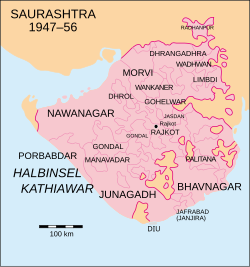Jafarabad State
| Jafarabad State Jafrabad State જાફરાબાદ રિયાસત | |||||||
|---|---|---|---|---|---|---|---|
| Princely State of British India In union with Janjira (1759–1948) | |||||||
| c. 1650–1948 | |||||||
|
Flag | |||||||
 Location of Jafrabad State in Saurashtra | |||||||
| Area | |||||||
• 1901 | 68 km2 (26 sq mi) | ||||||
| Population | |||||||
• 1901 | 12,097 | ||||||
| History | |||||||
| History | |||||||
• Established | c. 1650 | ||||||
| 1948 | |||||||
| |||||||
| Today part of | Gujarat, India | ||||||
Jafarabad, or Jafrabad State[citation needed], was a tributary princely state in India during the British Raj. It was located in the Kathiawar Peninsula on the Gujarat coast. The state had formerly been part of the Baroda Agency and later of the Kathiawar Agency of the Bombay Presidency.
Jafrabad State was a dependency of the Nawab of Janjira State,[1] located 320 km to the SSE on the Konkan coast. The states of Jafarabad and Janjira were united in a personal way.
Jafrabad town, the capital and only municipality, is located 275 km south of Ahmedabad and 240 southwest of Baroda. The state was formed by the city and 11 villages and initially consisted of two districts located on both sides of the estuary of the Ranai river. Jafrabad state had an area of 68 km2 and a population in 1881 of 4,746 and in 1901 of 6,038 inhabitants. The majority of the population were Muslims (80%) and the rest Hindus. The state and the town took their name from Sultan Muzaffar Jafar from Gujarat who built fortifications.[citation needed]
History[edit | edit source]
Jafarabad State was founded around 1650. On 6 December 1733 the ruler of Jafarabad State signed a defensive and offensive treaty with the British East India Company. In 1759, the Jafarabad and Janjira states entered into a personal union. Finally in 1834 Jafarabad State became a British protectorate.[2]
Around 1731 when the Mughal Empire rule was relaxed in Gujarat, the local Thanedar (ruler) who was an ally in the Muslim Mughal garrison became independent. Thereafter the Thanedar and the local Kolis were devoted to piracy, repeatedly attacking ships and disturbing commercial traffic from Surat. Sidi Hilal, the prince of the dynasty of Janjira which was then ruling Surat, attacked the Kolis, destroyed their boats and captured them demanding a hefty fine.[3] The Thanedar of Jafarabad could not afford to pay the fine and hence Jafarabad town was sold to Sidi Hilal in 1759.[citation needed]
Sidi Hilal soon realized that he could not keep the city given the situation of lawlessness in the Kathiawar peninsula and in 1762 he transferred Jafarabad to the Nawab of Janjira, who paid the debts and appointed him governor.
Under British protectorate the Nawabs of Janjira were considered separate second class rulers among the rulers of Kathiawar, but they were later promoted to first class. In the nineteenth century the rulers maintained a military force of 123 men. Jafarabad State acceded to the Indian Union on 8 March 1948.[4]
Rulers[edit | edit source]
Rulers initially held the title of Wazir and after 1803 the title of Nawab.[citation needed]
Thanadars of Jafarabad[edit | edit source]
- c.1650 – 16..: Fath Khan
- 16.. – 1678: Sambhol Yaqut Khan
- 1678 – 1734: Qasim Yakut Khan
- 1734 – 1759: Surur Khan
Wazirs of Janjira[edit | edit source]
- 1676 – 1703: Kasim Yaqut Khan II (d. 1703)
- 1703 – 1707: Amabat Yaqut Khan II
- 1707 – 1732: Surur Yakut Khan II (d. 1732)
- 1732 – 1734: Hasan Khan (1st time) (d. 1746)
- 1734 – 1737: Sumbul Khan
- 1737 – 1740: `Abd al-Rahman Khan
- 1740 – 1745: Hasan Khan (2nd time) (s.a.)
- 1745 – 1757: Ibrahim Khan I (1st time) (d. 1761)
- 1757: Mohammad Khan I (d. 1757)
- 1757 – 1759: Ibrahim Khan I (2nd time) (s.a.)
Thanadars of Jafarabad and Wazirs of Janjira[edit | edit source]
- 1759 – 1761: Ibrahim Khan I (s.a.)
- 1761 – 1772: Yaqut Khan (usurper to 6 June 1772) (d. 1772)
- 1772 – 1784: `Abd al-Rahim Khan (d. 1784)
- 1784 – 1789: Jowhar Khan (d. 1789)
- – in dispute with –
- 1784 – 1789: `Abd al-Karim Yaqut Khan
- – in dispute with –
- 1789 – 1794: Ibrahim Khan II (d. 1826)
- 1794 – 1803: Jumrud Khan (d. 1803)
Nawabs[edit | edit source]
- 1803 – 1826: Ibrahim Khan II (s.a.)
- 1826 – 31 August 1848: Mohammad Khan I (d. 1848)
- 31 Aug 1848 – 28 January 1879: Ibrahim Khan III (b. 1825 – d. 1879)
- 28 Jan 1879 – 2 May 1922: Ahmad Khan (b. 1862 – d. 1922) (from 1 January 1895, Sir Ahmad Khan)
- 28 Jun 1879 – 11 October 1883: .... – Regent
- 2 May 1922 – 15 August 1947: Mohammad Khan II (b. 1914 – d. 1972)
- 2 May 1922 – 9 November 1933: Kulsum Begum (f) – Regent (b. 1897 – d. 1959)
See also[edit | edit source]
References[edit | edit source]
- ↑ Chisholm, Hugh, ed. (1911). . Encyclopædia Britannica. Vol. 15 (11th ed.). Cambridge University Press. p. 125.
- ↑ Princely States of India
- ↑ Robbins, Kenneth X.; McLeod, John (2006). African elites in India: Habshi Amarat. Mapin. pp. 272 Pages. ISBN 1890206970.
- ↑ Great Britain India Office. The Imperial Gazetteer of India. Oxford: Clarendon Press, 1908
- Former country articles requiring maintenance
- Articles with unsourced statements from June 2020
- Articles with unsourced statements from August 2019
- Articles with unsourced statements from October 2015
- Bombay Presidency
- Muslim princely states of India
- Amreli district
- States and territories established in the 1650s
- 1650s establishments in India
- 1948 disestablishments in India
- Princely states of Gujarat
